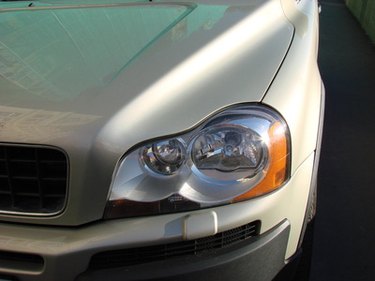Things You'll Need
Bowl
Liquid dish soap
Sand block made with industrial diamond
Soft cloth
Glass polish

Imperfections, raised surfaces and small surface cracks can be sanded out of glass. This process is most commonly used by auto mechanics to restore a headlight cover with a scratch. After the glass is sanded, it will have a dull, cloudy appearance. Glass polish brightens the glass and restores it to its clear and shiny appearance.
Step 1
Wear protective eye goggles and gloves. Tiny flecks of glass can fly during the sanding process so you you need to protect yourself.
Video of the Day
Step 2
Fill a bowl with warm water and a squirt of liquid dish soap. Dip a sand block made with industrial diamonds or one that specifies it's safe for use on glass into the soapy water. The sand block should be at least 600 grit. If you are unsure what grit to use, start with the lowest available grit and slowly work your way to a higher grit.
Step 3
Rub the dampened sand block back and forth in a scrubbing motion over the glass. This sands the glass. As the glass is being sanded, it will look cloudy instead of clear. If the glass still looks clear or the scratch or imperfection you are trying to remove is still present, select a sand block with a higher grit. Continue sanding until the desired result is achieved. Dip the block into the soapy water when it begins to dry out.
Step 4
Dampen a soft cloth with a glass polish. Rub the polish into the sanded glass so the entire surface is coated in a thin, even layer. Allow the polish to dry on the glass, which should take about 15 minutes.
Step 5
Buff the polish from the glass by rubbing a dry cloth into the polish in a circular motion. Continue buffing until all of the polish is removed. If residue remains, dampen the cloth under cool running water. Wring the cloth to remove all excess moisture. Buff out the remaining residue. Repeat steps 4 and 5 until the glass is clear and polished. This may take multiple attempts.
Video of the Day